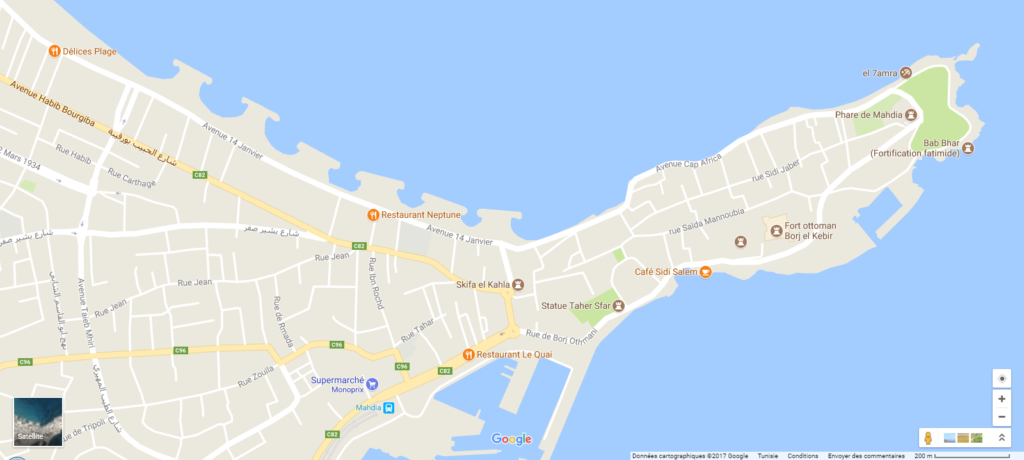MAHDIA
All you’ll need to know to make the most out of your time in Mahdia
HISTORY
INTRODUCTION
Founded in the early 10th century, Mahdia is today a quiet port town and provincial center of about 62,000 people, known for its fishing, silk weaving and olive industries. Mahdia is one of Tunisia’s most picturesque cities located between Sousse and Sfax. Its monumental gateway calls back to its glorious past: it was the first capital of the great Fatimid dynasty, who would go on to reign Cairo in Egypt and Syria. It has many historic attractions, including the ruins of an ancient Punic city (pre-dating Mahdia), the Fatimid port, the first Fatimid mosque (built in the 10th century), and a 16th-century Ottoman fort. Mahdia keeps its original traditions, where the women cover themselves with gold jewelry and the houses are decorated with embroidered hangings.
FATIMIDS
When, in 912, Obeid Allah El Mahdi, decided to choose a capital for the new Fatimid dynasty, as he moved away from Kairouan, he waited for his astrologists to read the stars and declare the predominance of the sign of the lion, a symbol of power, before deciding upon the site of Cap Africa – an old Carthaginian trading post forming an unassailable peninsula – and giving it the name: Mahdia. He had fortifications built around the town and at the narrowest point of the peninsula created an entrance guarded by an imposing gate called the “Skiffa El Kahla” (“The Dark Gate”). Behind this gate stood the Fatimids prince’s private kingdom and palace, the Great Mosque, the Civil Authority and handcraft shops.
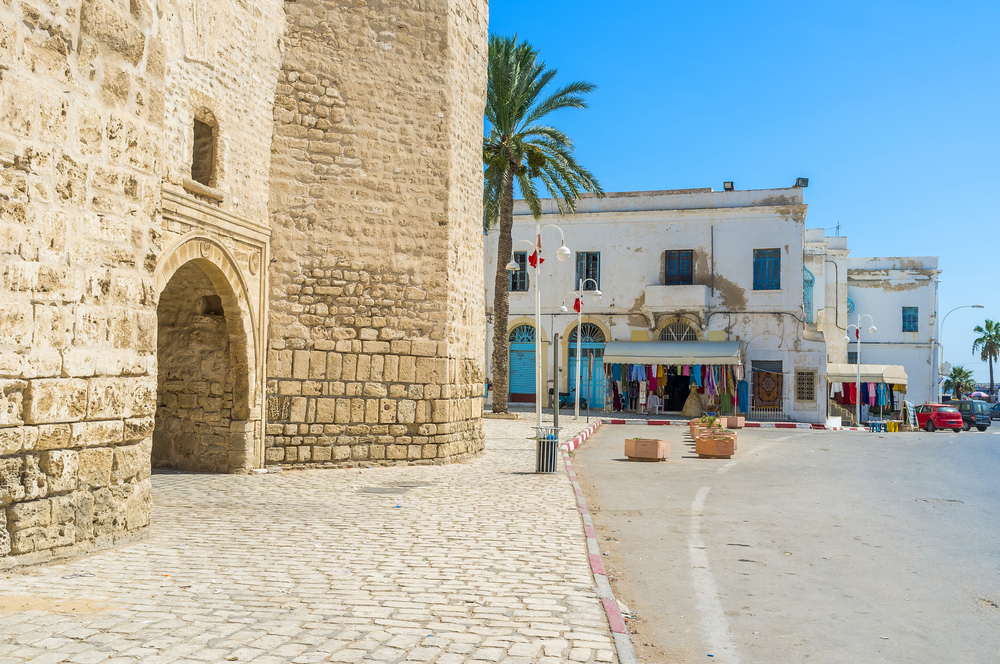
Craftsmen, including weavers, ironmongers and jewellers, as well as all shop owners were forced to live in Zouila, a newly built town on the mainland, which grew up as a thriving intellectual and artistic centre. Weakened by internal revolt and insurrection, however, the Fatimids chose to flee to Egypt, where they founded Cairo in 973.Then ruled by the Zirids, Mahdia was subsequently the object of the covetous designs of the Normans of Sicily, the Genoese, the Cavaliers of Malta until the Hafsid (1234), Mouradite (1612), then Husseinite (1705) dynasties brought stability to the area and populated it with Andalusians and then Anatolians, thus making Mahdia a town with a wealth of culture and tradition.
TREASURE
In 1907, off the coast of Mahdia, a few kilometres north of this prestigious town, sponge fisherman noted the presence of sunken artefacts. The seam contained columns, chapiteaux and further exploration revealed that it was in fact a boat full of art objects intended for the construction of a magnificent edifice. Quite a cargo! Besides the columns, the chapiteaux and superb marble craters, several works of art cast in bronze were salvaged from the wreck, such as the Agar, the Eros Citharede, the Hermes of Dionysos, the Dancing Dwarf, the Satire Race…as well as marble sculptures such as the divinely beautiful bust of Aphrodite.” (Mohamed Fantar)
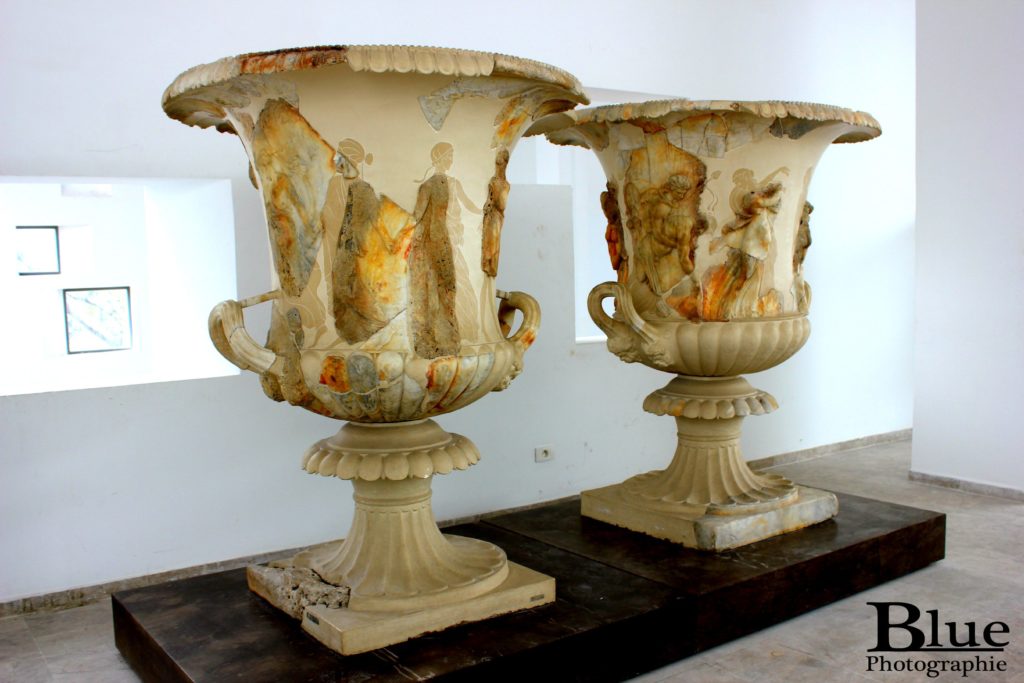
Mahdia’s magic cemetery casts its immaculate whiteness from one shore of the headland to the other. Its bright yellow daisy fields, which lie in the long shadows of the surrounding ruins, together with the wreckage which lies on the ashen rock of the nearby inlet, making this marine cemetery the most soothing, relaxing and spiritual place in the whole of the country.
TRADITIONS
At the weekly market, which takes place every Friday, the Skiffa El Kahla turns into an Ali Baba cave ‘worthy of the Thousand and One Nights, with the old weavers, embroiderers and dress-makers selling beautiful traditional costumes, silk products and gold-decorated outfits. Alongside there is also a lively gold jewellery market. This is the perfect opportunity to admire the brightly coloured silks and the meticulous gold-thread embroidery of the traditional attire of the women of Mahdia – which is without any doubt the most impressive of its kind in Tunisia.
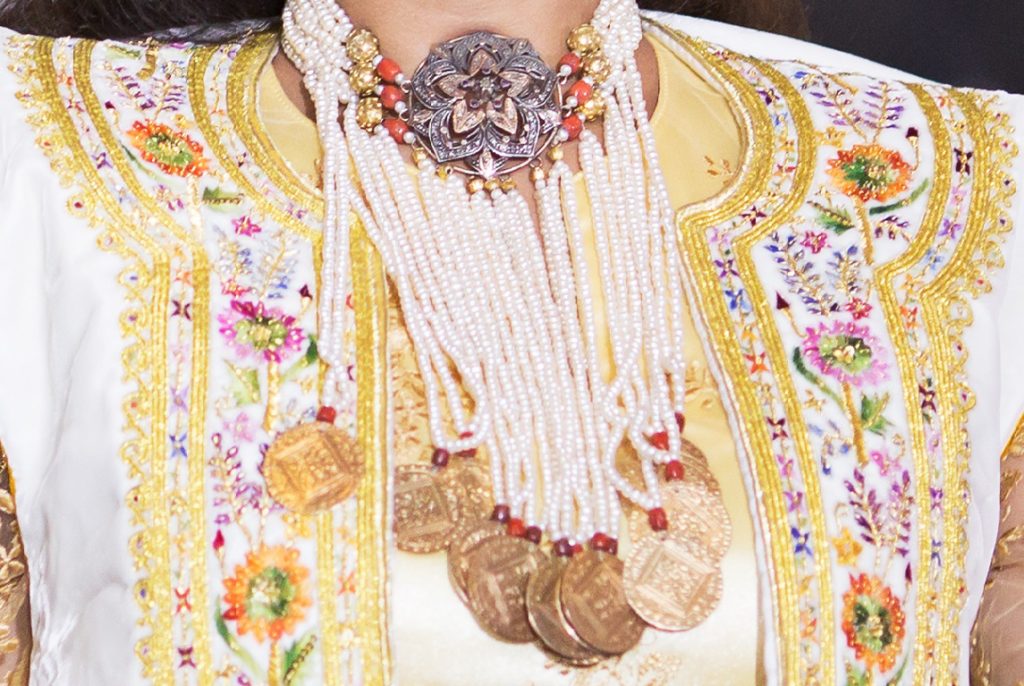
In Mahdia, the decoration which adorns the interior of the houses has become almost a place of worship. The “Dar”, or “House” is indeed an authentic work of art…In the most impressive dwellings, particularly in the rue des Hamza, on which a dozen beautiful houses, built during the last century by members of the same family, are clustered. The walls of the majiless (main room) are covered two-thirds of the way up with embroidered cloth, with the top part of the wall decorated with paintings. The brightly-coloured wooden shelves carry a multitude of fine potteries, subtly-coloured perfume bottles made from souffle glass and old gold-framed mirrors. The cornice and ceiling are painted with floral designs.
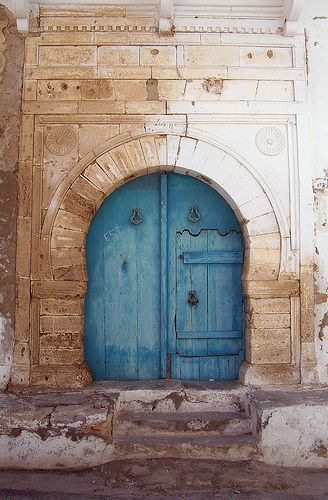
THINGS TO DO
There are many attractions to visit in Mahdia. You can visit all of them in half a day. If you leave from Mahdia Palace, we recommend catching a cab and going all the way east of Mahdia until Skifa el-Kahla and starting your itinerary right there.
Skifa el-Kahla
The Skifa el-Kahla, a massive fortified gate and one of Tunisia’s finest, is all that survives of the original Fatimid city. Entry is through a narrow, vaulted passageway, almost 50m long, that was once protected by a series of gates – one of them a suitably oversized iron portcullis. On market day, the interior is lined with impromptu stalls; it’s just possible to imagine you’re entering an ancient town little changed in centuries. For the view from the top of the gate, you’ll need to enter the museum adjacent to the gate.
Musée de Mahdia (Mahdia Museum)
This museum, just south of the Skifa el-Kahla, is small but excellent. The ground floor has three superb, expansive mosaics and nicely displayed marble statues dating from 3rd-century El-Jem. There are also oil lamps that once illuminated the corridors of the colosseum at El-Jem.
Upstairs are cedar panels adorned with Kufic script from the Great Mosque at Kairouan, as well as local costumes and coins from more recent Tunisian history.
Before leaving, don’t forget to climb to the top of the Skifa el-Kahla for the best views over the medina.
Marché (Market)
Every Friday, the old city transforms into an authentic oriental bazaar with the colours, smells and sounds taken straight from the pages of A Thousand and One Arabian Nights. It starts at Skiffa el-Kahla and goes along the old port until the Great Mosque. Expect a lively and crowded area filled with traditional items such as shishas, house decorations and souvenirs.
Jemaa el-Kebir (The Great Mosque)
The Great Mosque stands on the southern side of place Khadi en-Noamine. What you see today is a modern replica of the original Fatimid mosque, built by Obeid Allah in AD 921, which was destroyed when retreating Spanish troops blew up the city walls in 1554. Keep in mind Friday is the holy day of the week so tourists may not be able to access the mosque.
Café Sidi Salem
Not recognized for their service quality, this place is a must to grab a quick tea or coffee (not food!), and enjoy the beautiful view that is usually even better during the sunset. Useful tip: pay the waiter right when he serves you so you don’t have to wait after them.
Borj el-Kebir
This borj, also called Kasbah, is a fortress built at the end of the XVIth century on the site of the former Fatimid palace and is considered one of the finest specimens of Ottoman military architecture. Built on a quadrangular plan and later endowed with corner bastions, the building is surrounded by strong walls originally with one entrance only (after it was turned into a prison, another access was added in the XIXth century). This door leads through a vaulted and elbowed passage, into a courtyard onto which various vaulted rooms open. In the south-eastern corner of the courtyard, an earlier oratory was conserved and integrated into the building.
From the wall-walk, converted to a terrace, there is a lovely view over the tip of the Cape Mahdia promontory and, closer to the monument, over the ancient harbour basin (Punic Port) that certain specialists date to the Punic period.
Fatimid Fortifications & Cap d’Afrique
Fragments of the original Fatimid walls dot the shoreline from near the Great Mosque all the way to Cap d’Afrique, and provide just enough hints to imagine a walled town protected from sea-borne invasion. The Fatimid port remains in evidence here, as do the crumbling pillars that once flanked the entrance and dominated the harbour’s defences.
Maritime Cemetery
Much of the Cap is occupied by a vast cemetery, hundreds of white tombstones gleaming in the Mediterranean sun. It’s a very serene place, particularly at sunrise or sunset when the light isinfinitely soft.
The Lighthouse
The Mahdia Lighthouse is located next to the Cap d’Afrique and practically at the end of thepeninsula.
Avenue Cap Afrique
After leaving the lighthouse, you should head west and walk along the Avenue Cap d’Afrique which is a main street by the coast. For centuries, Mahdia was famous for the decoration of its homes also known as “Dar”. You will see the outside of beautiful houses which hide authentic works of art. We recommend you walk along the avenue and turn left on the street right before the café “El Koucha” and take your first right on Saida Mannoubia street to go towards the Place du Caire.
Place du Caire (Cairo Place)
The compact place du Caire is Mahdia at its best. The outdoor cafes under the generous shade of trees and vines are the perfect place to relax and contemplate the ornate arched doorway and octagonal minaret on the southern side of the square. They belong to the Mosque of Mustapha Hamza, built in 1772 when the square was the centre of the town’s wealthy Turkish quarter.
There are also some wonderful old Mahdia houses to admire.
Medina
There’s less commerce and more peaceful residential streets in Mahdia’s medina than in others in Tunisia, especially the closer you get to the lighthouse at Cap d’Afrique where the peninsula narrows and the sea is only steps away. The narrow, cobblestone streets are definitely photogenic.
RESTAURANTS
Coffee & Tea
Cafe Sidi Salem
Rue Burj Othmani
Cafes El Medina & Gamra
Rue Saida Mannoubia
Cafe marghoum
Avenue Taher Sfar
USEFUL INFO
Currency & budgets
The currency is the Tunisian Dinars. We recommend you exchange your dollars and euros at the Monastir airport. You can use your debit card at the banks to withdraw money not too far from Skifa el-Kahla or you can also find a bank right outside the hotel in the Diar el Bahr commercial center. You can also get some money exchanged at Mahdia Palace but expect higher rates.
A High-end restaurant meal will be around 40-50 dinars which is equivalent to about $15-20 USD. Fast food is much cheaper and you can get away with a $3-7 USD meal. Coffee and tea are even cheaper. Cabs are usually shared and you’ll be expected to pay by seat. Cost is around 1 or 2 dinars.
Local transportation
Mahdia is a small city so the best ways to get around are by foot in the old city (Medina/BurjRas). However, you should grab a yellow cab around the rest of town.
Health
No vaccinations are required. With its modern medical facilities and competent medical practitioners throughout the country, Tunisia guarantees holiday makers high quality healthcare and well being services, should they need them.
Pharmacies:
Turki: Av. N’hiri El Jem
Khalfallah: Place du 1er Mai
Clinic:
Clinique Errahma (next to Dar Shat)
Climate
For the month of June, temperatures tend to be around 25 to 29 Celsius (77 to 84 Fahrenheit) but the high humidity will make it feel hotter. However, the beaches are enjoyable and visitors will find that spending time in the water helps reduce the heat. At night, the temperature can drop, but this cool temperature makes the Mahdia evenings wonderful.
Visas
Canadian, American and EU citizens are not required to have a visa upon the entry to Tunisia. However, we recommend you consult the full list of countries exempt of visa to confirm your status: https://en.wikipedia.org/wiki/Visa_policy_of_Tunisia
Things to know
The 2011 Arab Spring has impacted the Tunisian administration and left a lack of organization for the past 6 years. It is getting way better and slowly back to normal, but you might see some trash laying around in some areas of the city and on the public beaches.
At the market or in the Medina, some vendors may be a little pushy to sell their products which are lovely but if you are not interested, simply say “non aychik”.
As in any country, watch out for minor thefts and make sure to keep an eye on your belongings and always use the safe in your hotel room!
If you leave the touristic area around the hotel, might be good to avoid being half naked even though it is hot !
MAP
